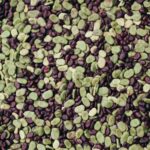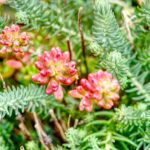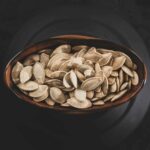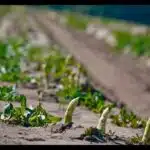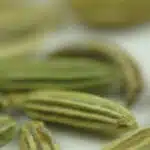Fava beans, also known as broad beans, are a nutritious and versatile legume that can be grown in a variety of climates. As a member of the pea family, fava beans are a rich source of protein, fiber, and essential vitamins and minerals. In addition to their nutritional value, fava beans can also improve soil fertility through their ability to fix nitrogen.
Growing fava beans requires careful attention to planting time, soil preparation, and pest management. Fava beans prefer cooler temperatures and well-drained soil with a pH between 6.0-7.0. They also benefit from regular watering and adequate sunlight. By following these tips along with proper harvesting techniques, gardeners can enjoy a bountiful crop of fava beans for use in soups, stews, salads, and other dishes. In this article, we will explore the steps involved in successfully growing fava beans in your home garden or farm.
Understanding The Benefits Of Growing Fava Beans
Fava beans, also known as broad beans, are a great addition to any garden for several reasons. According to recent statistics, fava beans account for 1.3% of the world’s legume production. This may seem small, but it shows that fava beans are gaining popularity and recognition for their benefits. One of the many benefits of growing fava beans is their nutritional value. Fava beans are an excellent source of protein, fiber, and iron.
In addition to being nutritious, fava beans have other benefits as well. They help improve soil health by fixing nitrogen in the soil through their root systems. This reduces the need for synthetic fertilizers and promotes sustainable agriculture practices. Furthermore, fava beans attract beneficial insects such as bees and butterflies which help pollinate other plants in the garden.
Growing fava beans can also be a cost-effective option for those looking to save money on groceries. With proper care and maintenance, one plant can produce up to 20 pods with 5-6 seeds each. This means that a single plant can yield up to two pounds of fresh fava beans! Overall, there are numerous benefits to growing fava beans ranging from their nutritional value to their ability to promote sustainable agriculture practices and save money on groceries.
Moving forward, choosing the right variety of fava bean is crucial for successful growth and development of these plants.
Choosing The Right Variety Of Fava Beans
The first step in growing fava beans is to select the right variety of seeds. There are many different varieties available, each with their own unique characteristics. Some varieties are better suited for colder climates, while others thrive in warmer temperatures. When selecting seeds, it is important to consider your climate and soil conditions, as well as your personal preferences.
Once you have selected your seeds, it is important to take good care of them during the seedling stage. This involves providing them with plenty of sunlight, water, and nutrients. You may also want to consider using a seed starting mix or potting soil to give them the best possible start. As they grow, be sure to thin out any weaker seedlings and provide support for the stronger ones.
In summary, selecting the right variety of fava bean seeds and providing proper care during the seedling stage are crucial steps in growing healthy and productive plants. By taking these steps, you can ensure that your fava beans will thrive and provide you with a bountiful harvest. In the next section, we will discuss how to prepare your soil for planting these wonderful beans.
Preparing The Soil For Planting
The success of growing fava beans greatly depends on the quality of the soil. Before planting, it is important to prepare the soil by composting and tilling in order to create a nutrient-rich environment that promotes healthy plant growth. Composting involves mixing organic materials such as leaves, grass clippings, and food scraps together in a pile and allowing them to decompose over time. This process creates a natural fertilizer that can be added to the soil before planting.
Tilling is another crucial step in preparing the soil for planting fava beans. This involves breaking up compacted soil by using a garden tiller or digging fork. Tilling improves drainage and allows air to circulate through the soil, which helps roots grow deeper and stronger. It also helps to incorporate any amendments such as compost into the soil more evenly.
When selecting fava bean seeds, it is important to choose heirloom varieties or disease-resistant strains. Heirloom varieties are open-pollinated plants that have been passed down through generations and have unique characteristics that make them well-suited for specific growing conditions. Disease-resistant strains are bred specifically to resist common diseases that affect fava beans, which can help ensure a higher yield come harvest time.
To ensure successful growth of your fava beans, it is essential to prepare the soil properly before planting. Composting and tilling are two critical steps in creating an ideal planting environment for your fava beans. Choosing high-quality seeds such as heirloom varieties or disease-resistant strains will also help set you up for success when it comes time to harvest your crop. In the next section, we will discuss when is the best time to plant your fava beans for optimal growth and yield potential.
Planting Fava Beans At The Right Time
When selecting a variety of fava bean to grow, factors such as climate, soil type and expected harvest time should be taken into consideration. Planting fava beans in the early spring as soon as the soil is workable is recommended to ensure the best growth and yield. Location should be chosen carefully, with an area that receives full sun and has well-drained soil being ideal. Fava beans require consistent moisture throughout the growing season, so regular and adequate watering is necessary. Fertilizing with a balanced fertilizer before planting and a nitrogen-rich fertilizer during the growing season can help optimize yields. Finally, good air circulation and soil preparation will help to ensure a successful harvest.
Choosing The Right Variety
In order to successfully grow fava beans, choosing the right variety is crucial. Varietal characteristics play a significant role in determining the success of your crop. When selecting seeds, it is important to consider factors such as growth habit, yield potential, and disease resistance. For example, if you live in an area with high humidity, selecting a variety with higher disease resistance would be beneficial.
Another important consideration when selecting fava bean seeds is their size. Larger seeds generally result in larger plants and higher yields. However, smaller seeds may have better disease resistance or perform better in certain growing conditions. It is also important to choose seeds that are free from damage or disease.
When it comes to planting fava beans at the right time, choosing the right variety can make all the difference. Some varieties are early maturing and can be planted earlier in the season, while others require a longer growing season and should be planted later. By carefully considering varietal characteristics and seed selection, you can ensure that your fava bean crop is successful and productive.
Planting Timing And Location
When it comes to planting fava beans, selecting the right variety is just one piece of the puzzle. Planting timing and location are also important factors that can significantly impact your crop’s success. To maximize your fava bean yields, it is essential to choose the best locations and timeframes for planting.
Fava beans prefer cooler temperatures and do not tolerate heat well, so they should be planted in early spring or late fall. The best time to plant depends on your location and climate, but in general, seeds should be sown as soon as the soil can be worked. In warmer climates, it may be necessary to plant in the fall and overwinter the plants for a spring harvest. When choosing a location for planting fava beans, look for areas with well-draining soil and full sun exposure.
To further maximize yields, there are several planting strategies that can be implemented. One such strategy is intercropping fava beans with other crops such as corn or squash. This not only helps maximize space utilization but also provides additional benefits such as improved soil quality and pest control. Another strategy is to plant fava beans in double rows rather than single rows, which allows for more plants per square foot while still providing enough space for growth. By utilizing these tips and strategies for planting timing and location, you can ensure a successful fava bean crop with maximum yield potential.
Watering And Fertilizing
When planting fava beans, choosing the right time and location is crucial for a successful crop. However, it’s also essential to implement proper watering and fertilizing techniques to maximize yield potential. Fava beans require consistent moisture throughout their growing season, but overwatering can lead to disease and root rot. Therefore, it’s important to find a balance that provides enough water without wasting resources.
One way to conserve water while still providing adequate moisture for fava beans is through organic options such as mulching. Mulch helps retain soil moisture, suppresses weed growth, and regulates soil temperature. Additionally, adding compost or organic fertilizer can help improve soil quality and provide necessary nutrients for healthy plant growth. It’s important to avoid using chemical fertilizers that can harm the environment and contaminate groundwater.
When it comes to watering fava beans, it’s best to use drip irrigation or soaker hoses rather than overhead sprinklers. This method allows for deeper penetration of water into the soil where roots can access it more efficiently. It also reduces evaporation and runoff, which conserves water resources. By implementing these strategies for watering and fertilizing fava beans, you can ensure a healthy crop with maximum yield potential while also promoting sustainable practices in your garden.
Watering And Fertilizing Fava Beans
Watering and fertilizing are crucial factors in the growth of fava beans. Fava beans require consistent watering to ensure that they get enough moisture for proper development. However, overwatering can lead to root rot, which can be detrimental to their growth. It is recommended to water fava beans deeply once a week during dry periods.
When it comes to fertilizing fava beans, organic fertilizers are the best option. They provide slow-release nutrients that help support plant growth without causing harm to the environment or plants. Compost and well-rotted manure are excellent sources of organic fertilizer for fava beans.
Companion planting is also an effective way of controlling pests in fava bean cultivation. Planting certain herbs such as marigold and basil alongside your fava beans can help repel pests like aphids and spider mites. Additionally, intercropping with other plants such as garlic or onions can help deter soil-borne pests from attacking your fava beans. With proper watering and fertilization techniques, combined with companion planting strategies, you can grow healthy and pest-free fava beans with ease.
To further enhance the growth of your fava beans, providing adequate sunlight is necessary. Fava beans thrive in full sun conditions and require at least six hours of direct sunlight daily for optimal growth. Therefore, it is essential to choose a location that receives sufficient sunlight when planting your fava bean seeds or seedlings.
Providing Adequate Sunlight
A crucial factor in maximizing yield when growing fava beans is providing adequate sunlight. Fava beans thrive in full sun, but too much of it can also cause sun damage to the plants. As such, it is important to balance the amount of sunlight they receive, especially during the hottest part of the day.
To prevent sun damage on fava bean plants, one effective technique is to provide some shade during peak daylight hours. This can be achieved through the use of shading netting or by planting taller crops nearby that can provide partial shade. Additionally, applying a layer of mulch around the base of each plant can help regulate soil temperature and moisture content, which also reduces the risk of sun damage.
In summary, ensuring that fava bean plants receive adequate sunlight while also preventing sun damage is critical for achieving a bountiful harvest. By providing partial shade during peak daylight hours and using mulch to regulate soil temperature and moisture content, gardeners can successfully grow healthy fava bean plants that produce high yields. In the subsequent section, we will discuss how mulching can further aid in retaining moisture for these plants.
Mulching To Retain Moisture
Mulching is an effective technique used by gardeners and farmers to conserve moisture in the soil. It involves covering the soil around plants with a layer of organic or inorganic material to prevent evaporation of water from the soil surface. Mulch also helps to regulate soil temperature, suppress weeds, and improve soil quality. In addition, mulching protects fava beans (broad beans) from damage caused by heavy rainfall, which can lead to leaching of nutrients from the soil.
One of the benefits of mulching is that it helps fava beans retain moisture in the soil. This is especially important during dry spells when there isn’t enough rainfall to keep the plants hydrated. By reducing water loss through evaporation, mulch ensures that the roots have access to water for longer periods. This way, fava beans can grow healthy and produce a bountiful harvest.
There are different types of mulch that are suitable for fava beans. Organic mulches such as straw, leaves, grass clippings, and compost provide additional nutrients as they decompose over time. They also help improve soil structure by increasing its porosity and promoting microbial activity. Inorganic mulches such as plastic film or stones don’t decompose but effectively suppress weed growth and reduce erosion caused by wind or rain. When choosing a type of mulch for your fava bean crop, consider availability, cost-effectiveness, and environmental impact.
As you can see, mulching has several benefits for growing fava beans successfully. It’s an easy technique that requires minimal effort yet yields significant results in terms of plant health and productivity. However, mulching alone may not be sufficient to support robust growth in fava beans; trellising may also be necessary to provide structural support as the plants get taller and heavier.
Trellising To Support Growth
As a wise horticulturist once said, “A plant without support is like a person without community – it may grow, but it will never reach its full potential.” The same can be said for fava beans. To truly thrive and produce bountiful harvests, these legumes require proper trellising to support their growth.
One key factor in trellising fava beans is bean spacing. When planting your beans, it’s important to leave enough room between each seedling to allow for proper air circulation and sun exposure. A good rule of thumb is to space each bean plant about 8-10 inches apart within rows that are 18-24 inches apart. This will ensure that the plants have enough space to grow tall and strong.
Once your fava beans are planted and beginning to grow, it’s time to think about vertical supports. These can come in many forms – from bamboo poles to wire cages – but the goal is always the same: provide sturdy structures for the plants to climb as they mature. By training your beans onto vertical supports, you not only maximize the use of garden space, but also help prevent disease by keeping leaves off the ground. With proper trellising techniques, your fava beans will have all the support they need to reach new heights of productivity.
To ensure that your fava beans continue thriving throughout their growing cycle, it’s essential to manage pests and diseases that may arise. From aphids to fungal infections, there are a number of threats that can impact these legumes if not properly addressed. In the next section, we’ll explore some effective methods for identifying and preventing these issues so you can keep your fava beans healthy and strong from start to finish.
Managing Pests And Diseases
One of the biggest challenges in growing fava beans is dealing with pests and diseases. These problems can significantly reduce the yield and quality of your harvest. However, by taking preventive measures and using organic solutions, you can keep your fava beans healthy and productive.
Prevention is always better than cure when it comes to pests and diseases. One way to prevent these problems is to plant disease-resistant varieties that are less susceptible to common pests and diseases. You should also maintain good hygiene practices such as removing plant debris, rotating crops, and keeping the soil well-drained to reduce the risk of fungal infections.
If you do encounter pests or diseases, there are plenty of organic solutions available that are safer for both you and the environment than chemical pesticides. For example, you can use insecticidal soap or neem oil to control aphids and other soft-bodied insects. You can also make your own homemade remedies using ingredients like garlic, chili pepper, or vinegar. Just be sure to follow the instructions carefully and apply them at the right time for maximum effectiveness.
To ensure a bountiful harvest of fava beans, it’s essential to manage pests and diseases effectively. By taking preventive measures like planting disease-resistant varieties and maintaining good hygiene practices, you can minimize the risk of these problems occurring in the first place. And if they do arise, don’t panic – there are plenty of organic solutions available that will help keep your plants healthy without harming yourself or the environment. In the next section, we’ll discuss how to tell when your fava beans are ready for harvesting so that you can enjoy them at their best!
Harvesting Fava Beans At The Right Time
Fava beans, also known as broad beans, are an important crop for many farmers and gardeners around the world. Identifying maturity of the plant is important for proper harvesting as the beans should be picked when they are young and tender for the best flavor. Timing of the harvest is also important, as fava beans should be picked at the end of the season, after the pods have dried and turned brown. Any pods that have not yet dried may still contain immature beans, which should not be harvested.
Identifying Maturity
Identifying maturity is crucial in determining when to harvest fava beans. The ideal time to harvest fava beans is when they reach full maturity, which varies depending on the cultivar and growing conditions. One way to identify maturity is by checking if the pods have filled out and are plump. Mature pods should be firm but not hard, and the seeds inside should be visible through the pod’s skin.
Another way to determine maturity is by observing the plant’s growth stage. Once fava bean plants start to flower, it takes around 80-100 days for them to reach full maturity. During this time, it is essential to monitor their growth regularly and check for signs of pests or diseases that could affect their development. Additionally, if you notice any brown spots on the leaves or stems, this could indicate a fungal infection that may impact pod development.
Harvesting techniques also play a vital role in identifying maturity. When harvesting fava beans, use sharp garden shears or scissors to prevent damaging the plant’s stem or other pods still developing on it. Gently pull each pod downward until it snaps off from the stem. Avoid yanking or twisting pods off as this can damage the plant and reduce future yields. Remember, harvesting at peak ripeness ensures maximum flavor and nutrient content while avoiding any bitter taste that can develop once overripe pods start drying out.
In conclusion, identifying maturity plays a critical role in harvesting fava beans at the right time. By monitoring plant growth stages, checking for signs of pests or disease, and using proper harvesting techniques, you can ensure your plants produce healthy and flavorful beans throughout their growing season.
Timing Of Harvest
To maximize yield and quality, timing of harvest is crucial when it comes to fava beans. Determining the right time to harvest can be challenging, but there are several methods you can use to ensure that you are harvesting at peak ripeness. One way is by observing the pods’ appearance and texture. Mature pods should be plump and firm but not hard, with seeds visible through the skin. Overripe pods can become dry and tough, while underripe ones may still be too soft or small.
Another essential factor in determining the timing of harvest is the growth stage of the plant. Fava bean plants typically take 80-100 days from planting to reach full maturity. Once they start producing flowers, you should begin monitoring their development closely so that you can harvest at the optimal time. Remember to check for signs of pests or disease throughout their growing season as well, as these can impact pod development.
Tips for maximizing yield include harvesting regularly once your plants start producing mature pods, rather than waiting until all of them have reached maturity simultaneously. This ensures that you can pick each pod at its peak ripeness before it starts to dry out or overripen. Additionally, using proper harvesting techniques such as sharp garden shears or scissors will help prevent damage to the plant’s stem or other developing pods. By following these guidelines and monitoring your fava bean plants closely, you can ensure that you are harvesting at the right time for maximum flavor and nutritional value.
Storing Fava Beans For Future Use
Once you have harvested your fava beans, it’s important to store them properly to ensure their longevity. One option is freezing, which can extend the life of your fava beans for up to six months. Start by blanching the beans in boiling water for two minutes, then transfer them to an ice bath for another two minutes. Drain and dry the beans before placing them in a freezer-safe container or bag. Label with the date and freeze.
Another option is to dry the beans for future use in traditional recipes such as falafel and hummus. To do this, spread your freshly harvested fava beans out on a clean surface in a single layer, making sure they are not touching each other. Allow them to air-dry completely over several days, turning them occasionally to ensure even drying. Once dry, store them in an airtight container or bag.
Freezing techniques and drying are just two ways you can store your fava beans for future use. Whether you love experimenting with new recipes or sticking with traditional ones, having fresh ingredients on hand can make mealtime more enjoyable. In the next section, we’ll explore how to prepare fava beans for cooking without any hassle so that you can spend less time prepping and more time enjoying your meals.
Preparing Fava Beans For Cooking
As the saying goes, “Preparation is key.” This holds true in cooking fava beans as well. After harvesting your fresh fava beans, it’s important to prepare them before cooking. This can be done by blanching them for a few minutes in boiling water and then removing their outer thick skin.
Blanching fava beans is a simple process that helps to make them more tender and easier to digest. After removing the outer skin, you can choose how you would like to cook them. One delicious way is by frying them in olive oil with garlic and herbs such as rosemary or thyme.
Frying fava beans adds a crispy texture and enhances their nutty flavor. They can be served as a side dish or added to salads for extra crunch. By preparing your fava beans properly, you can unlock their full potential and create a delicious dish that will impress your guests. Now that we know how to prepare fava beans for cooking, let’s explore some recipes that showcase their versatility and unique taste.
Exploring Recipes For Fava Beans
Fava beans (Vicia faba) have been used for centuries as a food source, with many traditional dishes developed around their use. Creative ideas for incorporating fava beans into recipes have been developed in recent years as a way to explore the versatility of this legume. Fava beans can offer a range of health benefits, including increased fiber intake and a potential decrease in cholesterol levels. Research has been conducted to explore the composition of fava beans and the potential nutritional benefits of their consumption. Traditional dishes featuring fava beans can offer a variety of flavors and textures, while creative ideas can be used to explore new ways of incorporating the bean into meals. Understanding the health benefits of fava beans can help inform how they can be used in recipes to maximize nutritional value.
Traditional Dishes
Fava beans, also known as broad beans, are a staple ingredient in traditional dishes from various cultures around the world. These dishes have significant cultural significance and evoke strong emotions in those who enjoy them. As a horticulture expert, I highly recommend growing fava beans to experience these rich culinary traditions.
One of the most famous traditional fava bean dishes is falafel from Middle Eastern cuisine. Made with ground fava beans mixed with herbs and spices, falafel is a vegetarian delight often served in pita bread with fresh vegetables and tahini sauce. Another popular dish is ful medames from Egypt, which consists of mashed fava beans seasoned with garlic, lemon juice, and olive oil served with flatbread. Both of these dishes have been passed down through generations and are deeply rooted in their respective cultures.
Growing your own fava beans not only allows you to enjoy these traditional dishes but also provides a sense of satisfaction that comes from growing your own food. Fava beans thrive in cool weather and should be planted in early spring or fall. They prefer well-draining soil and plenty of sunlight. Once harvested, the pods can be shelled to reveal tender green beans that can be used in a variety of recipes or stored for later use.
In conclusion, incorporating traditional fava bean dishes into your cooking repertoire is a great way to explore different cultures while enjoying delicious food. Growing your own fava beans adds an extra level of connection to these culinary traditions and provides the opportunity for a rewarding gardening experience.
Creative Ideas
As a horticulture expert, I believe that exploring fava bean recipes is an excellent way to experience the versatility of this nutritious legume. While traditional dishes like falafel and ful medames are undoubtedly delicious, there are many other unique uses for fava beans that can add variety to your meals.
One creative idea for incorporating fava beans into your cooking is to use them as a protein-rich base for dips and spreads. For example, you can blend cooked fava beans with garlic, lemon juice, and olive oil to make a creamy hummus-like dip. Alternatively, you can puree cooked fava beans with herbs like basil or parsley to make a flavorful spread that can be used on sandwiches or crackers.
Another innovative way to use fava beans is in vegetarian burgers or patties. When cooked and mashed together with breadcrumbs, eggs, and spices, the resulting mixture can be formed into patties and pan-fried until crispy on the outside and tender on the inside. These burgers can be served on buns with toppings like avocado, tomato, and lettuce for a satisfying plant-based meal.
In summary, exploring unique uses for fava bean recipes is an exciting way to expand your culinary horizons while enjoying the health benefits of this versatile legume. By using them as a base for dips or incorporating them into vegetarian burgers, you can create delicious meals that are sure to impress your guests while satisfying their desire for healthy food options.
Health Benefits
As a horticulture expert, it is important to highlight the nutritional content of fava beans. Fava beans are an excellent source of protein, fiber, and various essential vitamins and minerals. They are low in fat and calories and have been linked to several health benefits, such as improved digestion, lowered cholesterol levels, and reduced risk of heart disease.
The culinary uses of fava beans make them a versatile ingredient for healthy meals. Incorporating fava beans into your diet can be as simple as adding them to salads or soups. They can also be used as a substitute for meat in vegetarian dishes, making them an excellent plant-based protein option. Additionally, their creamy texture makes them ideal for dips and spreads, providing a nutritious alternative to high-fat options.
In conclusion, exploring recipes for fava beans not only provides delicious meal options but also promotes better health through their numerous nutritional benefits. Whether used as a base for dips or incorporated into vegetarian burgers, incorporating this nutrient-dense legume into your cooking repertoire is an easy way to improve your overall well-being while enjoying flavorful meals.
Using Fava Beans In Sustainable Agriculture
Sustainability practices are essential in the cultivation of fava beans. These practices help to ensure that the crop thrives while minimizing its impact on the environment. One such practice is crop rotation, which involves planting different crops in a given area each growing season. Crop rotation helps to prevent soil-borne diseases and pests that can damage fava bean plants. By rotating crops, farmers can break pest and disease cycles, improve soil health, and promote biodiversity.
Another sustainability practice in fava bean cultivation is the use of cover crops. Cover crops like clover or rye can be planted during fallow periods to protect the soil from erosion, restore nutrients, and maintain moisture levels. Cover crops also help to suppress weeds and provide habitat for beneficial insects like bees and ladybugs.
Incorporating sustainable practices into fava bean cultivation not only benefits the environment but also improves crop yield and quality. By promoting healthy soil, reducing pest pressure, and utilizing natural resources effectively, farmers can produce high-quality beans that are nutritious and flavorful while minimizing their environmental impact.
Transition: While incorporating sustainability practices is essential for successful fava bean cultivation, there may still be some common problems that arise during the growing process. To address these issues effectively, it’s important to understand how to troubleshoot them.
Troubleshooting Common Problems In Fava Bean Cultivation
Like any crop, fava bean cultivation can be plagued by various problems that can hamper its growth and yield. As a grower, it is important to anticipate these issues and take proactive measures to address them. Dealing with pests and optimizing soil pH are two of the most common concerns that gardeners encounter.
Pests such as aphids, mites, and thrips can cause significant damage to fava beans, both in terms of reducing yield and compromising the quality of the produce. To prevent infestations, it is crucial to keep the growing area clean and free from debris or weeds that could harbor pests. Additionally, using organic pesticides made from natural ingredients such as neem oil or garlic can help control pest populations without harming beneficial insects.
Soil pH also plays a critical role in fava bean cultivation. The ideal pH range for growing fava beans is 6.0-7.0; anything outside this range can lead to nutrient deficiencies or toxicities that affect plant health and yield. Regularly testing the soil pH and amending it as needed with organic matter such as compost or lime can help maintain optimal conditions for healthy growth. By taking proactive steps like these to address potential issues, growers can ensure a successful fava bean harvest year after year.
| Common Pest | Signs of Infestation | Prevention |
|---|---|---|
| Aphids | Curling leaves | Regularly inspect plants |
| Mites | Webbing on plant | Keep area clean |
| Thrips | Scarring on leaves | Use organic pesticides |
Table: Common Pests in Fava Bean Cultivation
Frequently Asked Questions
Can Fava Beans Grow Indoors?
Indoor gardening has become increasingly popular in recent years, with many people looking for ways to grow their own food in small spaces. Container farming is a great option for those who want to grow vegetables indoors, and there are many different types of plants that can thrive in containers. While fava beans (broad beans) are typically grown outdoors, it is possible to grow them indoors if the right conditions are met. However, it is important to note that fava beans require a lot of space and may not be the best choice for container farming. Other vegetables such as herbs, lettuce, and tomatoes are better suited for indoor gardening and can provide a bountiful harvest year-round. Ultimately, the decision to grow fava beans indoors should be made based on individual circumstances and preferences.
How Long Do Fava Beans Typically Take To Mature?
Fava beans, also known as broad beans, are a popular crop among gardeners due to their versatility and nutritional value. When it comes to the maturity of fava beans, the time frame can vary depending on several factors such as planting techniques and ideal growing conditions. Generally speaking, fava beans take around 80-100 days from sowing to harvest. However, this can be influenced by various factors such as temperature, soil quality, and moisture levels. In order to ensure optimal growth and maturity, it is recommended to plant fava beans in well-drained soil with plenty of organic matter, in a spot that receives full sun or partial shade. By following these ideal growing conditions and planting techniques for fava beans, one can expect a bountiful harvest of mature fava beans within the aforementioned time frame.
Can Fava Beans Be Grown In Containers?
Container gardening is an ideal solution for those who want to grow fava beans in a limited space. When it comes to growing fava beans in containers, it is essential to choose the appropriate soil and container size. Fava beans require well-draining soil with a pH level of around 6-7. A container size that offers enough space for root growth and allows proper drainage is also essential. The recommended container size for growing fava beans is at least 12 inches deep and wide. Regular watering and fertilization are also necessary for optimal growth. With proper care and attention, fava beans can thrive even in containers, providing a bountiful harvest for those with limited outdoor space.
How Do I Know If My Fava Beans Are Ready To Harvest?
Harvesting fava beans (broad beans) requires a certain level of skill and knowledge. The key to harvesting at the right time is to look for visual cues such as the pods turning pale green, bulging outwards, and becoming plump. Another effective technique is to feel the seeds inside the pod. If they are firm and have developed a good size, then it’s time to harvest. Once harvested, fava beans can be prepared in various ways, including roasted or boiled with salt and olive oil or used in soups and stews. Their nutty flavor makes them an excellent ingredient for vegetarian and vegan dishes. Learning these harvesting techniques can help maximize your yield while also providing culinary uses that will delight your taste buds.
Are Fava Beans Prone To Any Specific Diseases Or Pests?
In terms of disease prevention, fava beans are prone to a number of fungal infections. These include chocolate spot, rust, and blight. To prevent these diseases from taking hold, it is important to keep the plants well-aerated and free from moisture. Fungal spores thrive in damp conditions, so avoid watering the plants from above and instead aim for the soil around the base of the plant. In terms of pest control, fava beans can attract black aphids and bean weevils. The former can be controlled with a blast of water or by introducing natural predators like ladybugs or lacewings. Bean weevils can be prevented by rotating crops and avoiding planting beans in the same location year after year.
Conclusion
Fava beans, also known as broad beans, are a hardy and nutritious crop that can be grown both indoors and outdoors. While they prefer cool weather conditions, they can still thrive in warmer climates if given proper care. Fava beans typically take between 80-100 days to mature, depending on the variety and growing conditions.
If you’re short on space or don’t have access to a garden, fava beans can also be successfully grown in containers. It’s important to choose a container with good drainage and ensure the soil remains moist but not waterlogged. When it comes to harvesting fava beans, wait until the pods are plump and the beans inside have reached their full size before picking.
While fava beans are relatively easy to grow, they can be susceptible to certain diseases such as rust and chocolate spot, as well as pests like aphids and black bean aphids. To prevent these issues, practice good sanitation habits and keep an eye out for any signs of trouble. With a little bit of patience and care, you’ll soon be able to enjoy a bountiful harvest of delicious fava beans straight from your own garden or container.
Image Credits
- “File:Traditional Maltese Kusksu (Fava Bean Soup).jpg” by PolluxWorld (featured)




